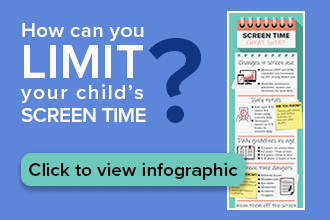Does eye strain cause myopia?

How are eye strain and myopia related?
As rates of eye strain and myopia rise, it’s reasonable to wonder if the two are related. Eye strain is associated with some of the activities that have been linked to myopia, such as extended near work and a lack of outdoor time. But researchers have not found that eye strain itself causes myopia.
To understand why not, it is helpful to become familiar with the symptoms and causes of eye strain. Plus, what have vision scientists learned about the causes of myopia?
What is eye strain?
Eye strain is the feeling of soreness and discomfort in the eyes. It can be accompanied by dry, burning eyes, an inability to focus and blurry vision. Some people may experience headaches along with eye strain.
Eye strain often results when near work requires a long period of focus and attention. Even with the correct prescription and healthy eyes, eye strain is not uncommon. Computer vision syndrome (also called digital eye strain) and extended use of digital devices such as tablets and smartphones are leading causes of eye strain.
Symptoms of eye strain will be worse later in the day than in the morning when your eyes are fully rested. The symptoms begin sooner and last longer when your eyes do not have a chance to rest.
When we look at a near object, such as a computer, the eyes accommodate in order to focus the image. After you have spent several hours looking at a screen, the eyes fatigue under the strain of continuous accommodation.
In addition to accommodation, the extraocular muscles must also work together to create a single image. After a few hours of near focus, the effort to maintain a single, clear image can exhaust the extraocular muscles as well. The sustained effort of continuous accommodation and convergence can result in eye strain.
Binocular vision issues — such as in esophoria, exophoria or convergence insufficiency can also result in eye strain. Binocular vision issues occur when the eye muscles are not working together and are imbalanced.
What causes myopia, and why it is not related to eye strain
Scientists have found that the risk of myopia increases with certain factors. While some of these risk factors are also associated with an increased risk of eye strain, there is not a causal relationship. This means that eye strain does not cause myopia.
Heredity
Many studies have found a clear link between the development of myopia and a person’s genetics. In fact, when both parents of a child have myopia, the child has a much higher chance of being myopic.
There is no clear relationship, however, between the genes that are linked to myopia and the causes of eyestrain.
Outdoor exposure
There is mounting evidence that children who don’t get enough outdoor exposure every day have a higher rate of myopia.
It’s also true that getting outside during the day and taking a break from near work is an effective strategy to relieve eye strain.
There is a decreased risk of both eye strain and myopia development by spending time outdoors. But, it does not establish a cause-and-effect relationship between eye strain and myopia.
Near work for extended periods
Some studies have shown a strong association between extended periods of near work without visual breaks and myopia. However, other studies have not found this association.
Extended periods of near work have been clearly identified as a major cause of eye strain. Although myopia and eye strain are both associated with a common trigger (excess near work), eye strain itself is not causing myopia. It is simply one of the symptoms.
In other words, it is the long periods of near work without a visual break that has been linked to myopia progression, not the eye strain itself.
Can I relieve eye strain and decrease my risk of myopia at the same time?
Yes! One of the best strategies to relieve eye strain and decrease your risk of myopia development, according to researchers, is to spend time outside every day.
If you are experiencing eye strain or blurry vision, see an eye doctor. Staying current on comprehensive eye exams will allow your eye doctor to monitor any eye strain and myopia symptoms you may be experiencing.
Asthenopia. American Academy of Ophthalmology. EyeWiki. August 2021.
Headaches. Nelson Pediatric Symptom-Based Diagnosis. Elsevier ScienceDirect. 2018.
Effects of age on dynamic accommodation. Ergonomics. July 2010.
Convergence insufficiency. EyeRounds.org. Ophthalmology and visual sciences. University of Iowa Health Care. December 2014.
Association between parental myopia and the risk of myopia in a child. Experimental and Therapeutic Medicine. April 2015.
Dose–response relationship of outdoor exposure and myopia indicators: A systematic review and meta-analysis of various research methods. International Journal of Environmental Research and Public Health. July 2019.
The association between near work activities and myopia in children — A systematic review and meta-analysis. Plos One. October 2015.
Page published on Wednesday, April 20, 2022
Page updated on Wednesday, April 20, 2022







